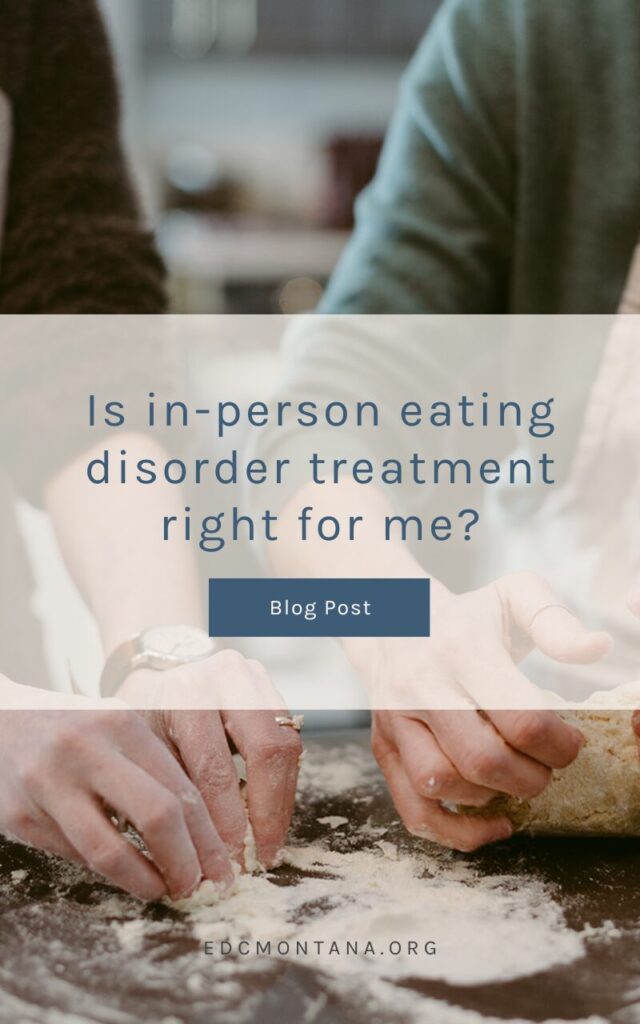Choosing the right type of treatment for an eating disorder is a deeply personal decision, and in today’s world of digital access and remote healthcare, there are more options than ever. While virtual care has increased accessibility — and sometimes it’s the only available option — it’s important to recognize the profound and lasting benefits that in-person treatment can offer.
As the only in-person option for a higher level of care in Montana, we want to highlight why in-person eating disorder treatment remains the gold standard, and how it can provide irreplaceable support, structure, and healing.
Tailored Support for Neurodivergent Individuals
For neurodivergent patients, especially those with ADHD or autism spectrum disorder, in-person treatment can be especially beneficial. The structure and sensory regulation provided by a real-world treatment environment often help patients feel more grounded and supported.
Many individuals with ADHD, for example, struggle with sustained attention, task initiation, or time blindness. In a virtual setting, these executive functioning challenges can become obstacles to participating fully in groups, completing meals, or staying engaged in individual therapy. In contrast, the external scaffolding of an in-person program (meal support, face-to-face accountability, and real-time redirection) can significantly improve therapeutic outcomes and help patients stay regulated.
Daily Medical Oversight from Specialized Professionals
Eating disorders impact both mental and physical health, and the medical complications, especially during refeeding or weight restoration, can be serious. In-person treatment offers the benefit of continuous medical monitoring by registered nurses and medical professionals who specialize in eating disorders and provide nonjudgmental and inclusive care.
This includes regular blind weights (where you aren’t shown the number, to reduce anxiety and fixation), daily vitals checks, and prompt lab work when needed. These routine check-ins aren’t just about data, they help us catch complications early, ensure that your body is healing alongside your mind, and provide a layer of safety that virtual care often cannot replicate.
When patients are in virtual treatment, they typically need to coordinate medical monitoring with an outside provider, which can add logistical and emotional stress. In-person care removes that burden and allows for a more seamless, integrated approach to your health.
Evidence-Based, Gold Standard Care
While telehealth has gained traction in recent years, the majority of research on effective eating disorder treatment has been conducted in in-person settings. We still don’t have enough long-term data on the efficacy of virtual models, especially for higher levels of care like partial hospitalization (PHP).
In-person treatment has decades of research supporting its effectiveness. It provides a structured, therapeutic environment where clinical teams can adjust care in real time and collaborate in ways that are often more difficult to replicate virtually.
Hands-On Learning that Builds Confidence and Skills
Recovery from an eating disorder isn’t just about stopping disordered behaviors, it’s about building a new relationship with food, your body, and yourself. In-person treatment allows you to practice these new skills in real-time, with real-life support.
This might mean learning how to portion and plate a balanced meal with guidance from a dietitian, or practicing grounding techniques with a therapist during a difficult meal or body image moment. These skills are not theoretical, they’re practiced over and over, so that when you return home, you have the confidence and muscle memory to carry them with you.
The Power of Peer Connection and Community
One of the most beautiful and healing parts of in-person treatment happens in the small, unstructured moments: the quiet conversation with a peer while wiping down a table after a meal, the supportive glance exchanged during a hard group, or the spontaneous encouragement from a staff member in the hallway. Let’s not forget that fun and playfulness are what knit in the healing — whether it’s through a shared laugh in art therapy or the deep calm found in a restorative yoga session. These moments foster a sense of community and shared understanding that can’t easily be recreated over Zoom.
Our milieu therapists are specifically on our team to support patients during these in-between moments; between structured groups, before or after individual therapy or nutritional therapy, or during breaks. They get to know each patient on a personal level, separate from their treatment plan or diagnosis, providing an immense amount of individualized support that really makes in-person treatment stand out from virtual care.
In virtual care, group time tends to be highly structured, with little space for natural connection. But in recovery, those relational moments can be some of the most powerful catalysts for healing and reminders that you’re not alone.
_____________________________________
Many patients consider virtual care because they hope to fit treatment around their regular responsibilities like work, school, and family. And sometimes that truly is the only feasible option. But if there’s space in your life to step away and immerse yourself in recovery, the benefits of doing so can be profound.
In-person treatment gives you the opportunity to pause, to refocus entirely on your healing, and to begin rebuilding your life with intention and support. Recovery is hard, vulnerable work, but it’s also sacred. And you deserve to give it the time, space, and attention it requires.

